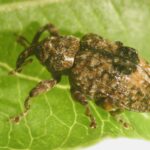Curculio migration continues as codling moth eggs develop. Stay covered!

During the thinning period thinning rates of carbaryl may have bought some time between applications, helping to reduce fruit injury between insecticide applications targeting the PC.
In the mid-Hudson Valley we presently have 123 accumulated degree-days (base 50°F) from petal fall (May 14th) through today, May 25th in Highland, NY. Effective insecticide residual should be maintained until 308 degree days have accumulated from your petal fall date of McIntosh. Using predicted temperatures over the next 10 days, we expect to accumulate an average of 23.7DD per day, bringing the forecast date for the 308DD completion of PC migration to June 1ST.
If you recovered (1st cover application) with a reliable PC insecticide at a robust rate, on the 24th of May (10d post PF) you would be out <10 days to the predicted end of PC emergence. The residual for the high-labeled rate of Calypso at 8 oz./A or Imidan at 5.75 lb./A for example, should be sufficient to carry you through to the end of a 10-day PC migration. The model for PC migration takes into account that the adults that have entered conventional orchards have been killed off by the PF and 1st Cover insecticides. This is not the case in organic production systems in which Surround WP residual needs to protect the fruit from PC injury for most of the early season, well past the end of migration.

However, rainfall is predicted over the next 4 days with 30-40% chance of rain. Thunderstorms carrying high winds and significantly higher rainfall can add much higher amounts of rain and residual losses of contact insecticides. Accumulations of up to 1” of rainfall is predicted by Wednesday with additional forecasts of 50% thunderstorms through Sunday.
That said it is likely that you will need to recover if > 1” of rain falls prior to the 1st of June. Also consider an insecticide application to pick up the last of the PC along with the upcoming Codling Moth (CM) larval emergence. First CM eggs are laid at about 50 DD and the first eggs usually hatch after about 220 DD (by Wednesday of this week).
The neonicotinoid Calypso 4F® (thiacloprid), the OP Imidan 70WP®, WSP® (Phosmet), carbamate; Sevin® (carbaryl), and pyrethroids Danitol 2.4EC® (fenpropathrin), Asana XL® (esfenvalerate), Baythroid XL 1E®, 2EC® (beta-cyfluthrin), Lambda-Cy 1CS® (lambda-cyhalothrin), Warrior 1CS® (lambda-cyhalothrin), Proaxis 0.5CS®, and pre-mix formulations *Endigo ZC® (lambda-cyhalothrin / thiamethoxam), Leverage 360® (imidacloprid / beta-cyfluthrin), Gladiator® (zeta-cypermethrin / avermectin), *Voliam Express® (lambda-cyhalothrin / thiamethoxam), *Voliam Flexi® (chlorantraniliprol / thiamethoxam), should provide excellent control of both insects.
Detailed insecticide information for plum curculio (and other insects) can also be found here
*Conserving pre-mix insecticides such as Leverage and those that contain thiamethoxam should be strongly considered for later in the season as brown marmorated stink bug moves into tree fruit. The active ingredient thiamethoxam is effective in BMSB management with labeling restrictions limiting use to only a single application. For CM management, DO NOT USE ACTARA ALONE. It has good PC activity, however, it has very little efficacy against CM.
“Throughout the Hudson Valley, the incidence of observed PC damage is highly variable among different orchards. PC damage usually occurs primarily along the edges of commercial orchards, and noticeable damage occurs in the same locations in orchards year after year, regardless of treatment levels. Therefore, the potential for damage in any particular orchard can be predicted from past observations. Usually, a post-petal fall spray for control of PC is not necessary in low-pressure orchards in which no damage has been observed in the past. In high-pressure orchards, additional sprays along the perimeter of the orchards should be applied until the oviposition model predicts that control is no longer necessary.” (PMEP Quote)
